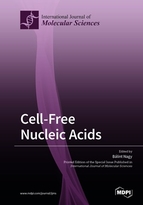Cell-Free Nucleic Acids
A special issue of International Journal of Molecular Sciences (ISSN 1422-0067). This special issue belongs to the section "Molecular Pathology, Diagnostics, and Therapeutics".
Deadline for manuscript submissions: closed (30 June 2019) | Viewed by 63894
Special Issue Editor
Interests: comparison of nucleic acid isolation methods; cell-free nucleic acid isolation; gene expression measurement; clinical application of liquid biopsy; diagnosis of genetic diseases; cell-free gDNA; mtDNA; miRNA and lncRNA studies in oncological and cardiovascular diseases; exosome isolation methods; nucleic acid measurements from exosomes
Special Issues, Collections and Topics in MDPI journals
Special Issue Information
Dear Colleagues,
Liquid biopsy has recently become a very popular sampling procedure. The main advantage of this method is the possibility of easy cell-free nucleic acids isolation from different bloody fluids and their use in diagnostic or screening processes. The other advantage is the possibility to follow up patients’ treatments. Liquid biopsy is applicable during the diagnosis of oncological, cardiovascular, and infectious diseases. Gene expression studies on gDNA, mtDNA, miRNA, and lncRNA could give valuable information to researchers and clinicians. Currently, it is very popular to obtain exosomes from liquid biopsies and use them in similar studies. Understanding their role in different pathological conditions could give us valuable information on cell-cell-tissue communication. The identification of new extra- and intracellular signaling nucleic acid molecules and pathways could help in the diagnosis and treatment of patients.
Cell-free DNAs are widely used in the prenatal detection of genetic diseases. Recently oncological diseases are the focus of research and the newest area is the cardiovascular diseases.
Therefore, authors are invited to submit original research and review articles which address the progress and current standing of cell-free nucleic acids.
Topics include, but are not limited to:
- Gene expression studies in different diseases using cell-free nucleic acids;
- Use of cell-free nucleic acids as biomarkers in different diseases;
- Techniques for isolation, detection, analysis, and identification of signaling nucleic acid molecules, pathways, and networks.
Prof. Bálint Nagy
Guest Editor
Manuscript Submission Information
Manuscripts should be submitted online at www.mdpi.com by registering and logging in to this website. Once you are registered, click here to go to the submission form. Manuscripts can be submitted until the deadline. All submissions that pass pre-check are peer-reviewed. Accepted papers will be published continuously in the journal (as soon as accepted) and will be listed together on the special issue website. Research articles, review articles as well as short communications are invited. For planned papers, a title and short abstract (about 100 words) can be sent to the Editorial Office for announcement on this website.
Submitted manuscripts should not have been published previously, nor be under consideration for publication elsewhere (except conference proceedings papers). All manuscripts are thoroughly refereed through a single-blind peer-review process. A guide for authors and other relevant information for submission of manuscripts is available on the Instructions for Authors page. International Journal of Molecular Sciences is an international peer-reviewed open access semimonthly journal published by MDPI.
Please visit the Instructions for Authors page before submitting a manuscript. There is an Article Processing Charge (APC) for publication in this open access journal. For details about the APC please see here. Submitted papers should be well formatted and use good English. Authors may use MDPI's English editing service prior to publication or during author revisions.
Keywords
- Cell-free nucleic acids
- Liquid biopsy
- Gene expression
- Prenatal diagnosis
- Oncology
- Cardiovascular diseases
- Exosomes







